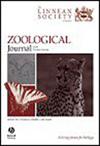Description of three new species of Zenometridae (Echinodermata, Crinoidea, Comatulida), with new insights on species and genus delimitation
IF 2.8
2区 生物学
Q1 ZOOLOGY
引用次数: 0
Abstract
Zenometridae A.H. Clark, 1909 is a family of Comatulida that co-habits with corals or sponges in the deep-sea. It comprises five species attributed to three genera, characterized by a cavernous centrodorsal cavity, a complete basal circlet with a large central lumen, and a concave fulcral bowl of the cirrus sockets. This study reveals a high cryptic diversity of the family, with three new species (Sarametra varians sp. nov., Sarametra subtilis sp. nov., and Sarametra acuta sp. nov.), two undescribed species, and a novel clade from the Pacific Ocean. The new species demonstrate limited intra-specific COI genetic divergence (< 0.4%), yet showing a spectrum of morphological variations that used to be considered as intergeneric differences. A review of characters is carried out based on the new specimens and type specimens of the five known species. COI, 16S, and 28S genes are used for phylogenetic reconstruction, providing the first molecular phylogenetic tree of the family. Genera Psathyrometra and Sarametra are monophyletic with robust supports. A novel clade, Zenometridae gen. et sp. indet., is retrieved as sister to the Sarametra clade. The integration of molecular and morphological data has led to a revision of the generic diagnosis, offering a better understanding of the taxonomy and evolutionary relationships of the family.刺甲科三新种记述(棘皮科、海百合科、狐尾蛛科)及种属划分新认识
Zenometridae A.H. Clark, 1909是与珊瑚或海绵共同生活在深海中的Comatulida家族。它包括隶属于3属的5种,其特征是海绵状的中心背腔,具有大中心腔的完整的基圆,和卷云窝凹的支点碗。这项研究揭示了该科的高度隐秘性多样性,包括三个新种(Sarametra varians sp. nov., Sarametra subtilis sp. nov.和Sarametra acuta sp. nov.),两个未描述的物种和一个来自太平洋的新分支。新物种显示出有限的种内COI遗传差异(< 0.4%),但显示出过去被认为是属间差异的形态变异谱。根据已知五种的新标本和模式标本,对其性状进行了综述。COI, 16S和28S基因用于系统发育重建,提供了该家族的第一个分子系统发育树。Psathyrometra属和Sarametra属是单系植物,具有强大的支撑物。一个新进化支,天牛科。,是萨拉梅特拉分支的姊妹分支。分子和形态学数据的整合导致了对一般诊断的修订,提供了一个更好的理解分类和进化关系的家庭。
本文章由计算机程序翻译,如有差异,请以英文原文为准。
求助全文
约1分钟内获得全文
求助全文
来源期刊
CiteScore
6.50
自引率
10.70%
发文量
116
审稿时长
6-12 weeks
期刊介绍:
The Zoological Journal of the Linnean Society publishes papers on systematic and evolutionary zoology and comparative, functional and other studies where relevant to these areas. Studies of extinct as well as living animals are included. Reviews are also published; these may be invited by the Editorial Board, but uninvited reviews may also be considered. The Zoological Journal also has a wide circulation amongst zoologists and although narrowly specialized papers are not excluded, potential authors should bear that readership in mind.

 求助内容:
求助内容: 应助结果提醒方式:
应助结果提醒方式:


